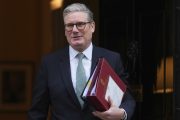
It’s been a contentious April Fool’s Day in the House of Commons as members of Parliament discussed ways to move forward on Brexit. The debate is happening as Prime Minister Theresa May is contemplating bringing her thrice-defeated Brexit deal with the EU up for a vote yet again.
In a scene that sums up the absurdity of how the British government has botched Brexit, several climate activists from a group known as Extinction Rebellion, wearing nothing but their indignation and some underwear, spiced things up. MP James Heappey tweeted a photo of the activities.
The House of Commons today was set to vote on four alternative plans for Brexit in another round of non-binding indicative votes. As the name implies, these indicative votes test the support for each plan, indicating what approach might have the best chance moving forward.
Speaker John Bercow selected four of the eight indicative votes, which all failed on Friday. Today’s parliamentary discussion focused on these options:
Motion C: Customs Union
Former Tory Chancellor Ken Clarke’s plan calls for any Brexit agreement to include a binding commitment to negotiate a “permanent and comprehensive UK-wide customs union with the EU.” In Friday’s round of indicative votes, this plan lost by the closest margin, 271-265.
Motion D: Common Market 2.0
This motion was brought forth by a group of Labour and Tory MPs and calls for U.K. membership in the European Free Trade Association as well as the European Economic Area. The U.K. would continue to participate in the single European market and have a “comprehensive customs arrangement” with the EU. This is also called the “Norway Plus” plan. It was defeated on Friday 283-189.
Motion E: Confirmatory Public Vote
While this motion received the most number of votes (268) in Friday’s round of indicative votes, it’s not truly a plan. All it does is require that any agreement that Parliament finally does come to be put to a public vote to confirm that Brexit can move forward in that way. It passes the decision to move forward back to the people. It was defeated on Friday 295-268.
Motion G: Parliamentary Supremacy
This motion calls for parliament to seek an extension to the Brexit process from the EU. If that isn’t possible, parliament would vote on whether to leave the EU with no deal or revoke Article 50 altogether, in effect cancelling out the original Brexit vote by the people in 2016. This was defeated on Friday by 293-184.
All of these options are flawed in one way or another. They also lack something that Theresa May’s deal already has, namely, EU support. The EU can simply nix any of these options no matter what the House of Commons comes up with.
And that is the embattled May’s one trump card in the process, and why she may be considering a fourth attempt to get her deal passed, even after proclaiming on Friday that the U.K. would need “an alternative way forward” after her plan was defeated.
May’s plan has done a little better each time it has come up for a vote. In January, the plan suffered one of the worst defeats in the history of the House of Commons, losing by 230 votes. The next time it came up for a vote in mid-March, it lost by 149 votes, and on Friday, it lost by 58 votes.
May’s deal still lacks key support from Northern Ireland’s Democratic Unionist Party (DUP), which has propped up May’s coalition government in the past.
The clock, as they say, is ticking. Friday was the day that the U.K. was originally scheduled to leave the EU, so this is an overtime period. April 12 is the next deadline for the U.K. to pass May’s deal, come up with a new plan acceptable to both Parliament and the EU, or leave without a deal in place.
Politicians have attempted to make that third option — the “no deal” option — such a frightening scenario that few in the House of Commons even wish to think about it. But the stories of food shortages, travel disruption, and customs chaos have been vastly overblown. Both Great Britain and the EU have developed contingency plans in the case of “no deal.”
But the fear of no deal and the lack of EU agreement may just make Theresa May’s thrice-defeated “soft” Brexit plan the best option in the eyes of British Parliament.
Photo: AP Images



